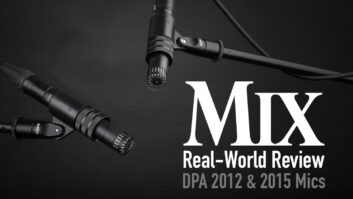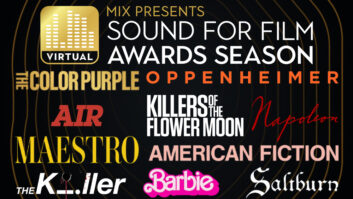This special March issue marks the 11th year of the Pro Sound News Centerstage Awards, which were created to acknowledge today’s top live sound engineers; recognizing that “the cream rises to the top,” the engineers chosen all worked on the three top-grossing North American tours of 2011*.
All the engineers profiled here have spent decades on the road, honing their skills to a fine point, even as they have become leaders in their field. One thing that unites all of them, however, is the level of dedication that each one exhibits each time he steps behind a mixing desk.
Acts like U2, Taylor Swift and Kenny Chesney—artists who demand and receive the best production support available—entrust their careers to these audio engineers, night after night. Accordingly, the Centerstage Awards are an effort to highlight the contributions that these professionals have made to the live sound industry, the artists they’ve worked for, and the audiences they’ve thrilled around the world. * according to Pollstar
The U2 Audio Crew (l-r): Richard Rainey, Edge monitor engineer, far left; Joe O’Herlihy, U2 sound director/FOH engineer, third from
left; C.J. Eiriksson, Mullen/Clayton monitor
engineer, center in back, with orange stage
piece pointing to him; Alastair McMillan,
Bono monitor engineer, far right.

#1 U2
The U2 360° Tour, which wrapped up at the end of July 2011, was one for the history books: a two-year, 110-date trek that broke Billboard’s all-time attendance and box office gross records. That easily made it the top-grossing tour last year, according to Pollstar, as it garnered $156 million during its final U.S. leg, selling 1,701,486 tickets across a mere 25 shows.
“The integration of the Clair i5 sound system into the 360-degree architectural structure design was the vital ingredient to the success of the sound design working or not,” comments Joe O’Herlihy, U2 sound director and FOH mixer. O’Herlihy, along with Bono’s monitor engineer and live recording engineer, Alastair McMillan, also received Centerstage Awards in 2010 for the jaunt’s initial U.S. leg.
O’Herlihy was assisted by a sound team that acoustically mapped every venue on the tour in advance. “On a more practical perspective, we knew we had to move this massive sound system from venue to venue, so that also had to be proactively achievable. But thanks to lighter weight, lowerprofile speaker cabinets and digital mixing consoles, a show—even of this magnitude—can be designed, set up, run and loaded out in a timely manner. All in a day’s work, really—48 hours a day, eight days a week!” says O’Herlihy.
McMillan took the tour in stride: “Once I got my head around the DiGiCo SD7, it was all smooth sailing.” There really was no low point, other than the tour coming to an end, he says. “At one point, I was stretchered out to have my appendix removed. Even that was a highpoint—it was a really exciting way to undergo an emergency operation!”
Plus, as McMillan notes, “I was on tour with the best crew and the best rock ’n’ roll band on the planet.”
CJ Eiriksson, mixing monitors for Larry Mullen, Jr., Adam Clayton and keyboardist Terry Lawless (positioned, along with the monitor engineers, under the stage), joined mid-tour, taking over from veteran Dave Skaff. “The biggest challenge was trying to make the mixes better each night, while also keeping consistent,” he says.
One night, everything got away from Eiriksson: “I simply had to brush it off, refocus and work even harder to get back to the high-quality mixes I was striving for. My high point had to be when I finally started doing more of my own thing.”
Richard Rainey, who took over mixing for The Edge’s in-ears from another veteran, Niall Slevin, comments, “The biggest challenge was dealing with less than ideal acoustics in a lot of the stadiums and how they impacted on your mix. Joining the tour halfway was actually great, as the system had been up and running successfully for a long time and most problems had already been encountered.”
Both McMillan and Rainey count some of the larger shows among the tour’s highlights. McMillan says, “The one that springs to mind is Mexico at the start of the U.S. leg. When the band played “I Will Follow,” all 100,000 people started to jump up and down in unison. The whole stadium shook—I had to hold on to the desk to stop it coming off the stand!”
It takes a lot of people to stage such a massive production, of course. “I would like to thank Jake Berry and his production team for making the U2 360° Tour the groundbreaking and hugely successful tour it became,” says O’Herlihy. “I would sincerely like to say a very special thank you to Troy Clair for his belief in the sound design brief, not to mention his extraordinary support and huge financial commitment to the fruition of the ideal as a sound concept.”
The monitor mixers also join O’Herlihy in thanking the entire sound crew: senior systems engineer and sound crew chief, Jo Ravitch, Rich Schoenadel, Vincent Perreux, Jason Brace, Chris Holland, Jason O’Dell, Tom ‘Duds’ Ford, Chris Fulton, Ben Blocker, Hannes Dander, Pascal Harlaut, Joel Merrill, Jennifer Smola, with special thanks to Niall Slevin and Dave Skaff, and backline crew Sam O’Sullivan, Dallas Schoo, Stuart Morgan, Phil Docherty, and ‘Rab’ McAllister.
Steve Harvey
Vital Stats U2 Clair
Sound Director/FOH Engineer:
Joe O’Herlihy
Monitor Engineer:
CJ Erikson, Richard Rainey,
Alastair McMillan
Crew Chief/System Engineer:
Jo Ravitch
Asst. Systems Engineer:
Vincent Perreux
Systems Engineer 2:
Rich Schoenadel
Asst. Monitor Engineer:
Chris Holland, Jason Brace
Systems/Patch Techs:
Jason O’Dell, Tom Ford
Techs:
Jen Smola, Ben Blocker,
Pascal Harlaut, Hannes Dander,
Joel Merrill, Chris Fulton
FOH Console:
DiGiCo SD7
Monitor Console:
DiGiCo SD7; Avid Venue Profile; Midas Venice 160
House Speakers:
Clair i-5, i-5b, SLP, FF2, BT-218, i-DL
Monitor Speakers:
Clair 12AMII “Stealth” wedges, ML-18, i-5b
Personal Monitors:
Future Sonics; Sennheiser 2000
House Amplifiers:
Lab.gruppen PLM 20000Q, PLM 14000
Monitor Amplifiers:
Lab.gruppen PLM 20000Q, PLM 14000, PLM 10000Q, FP2400Q
FOH Equipment/Plug- Ins:
TC Electronic 2290; Eventide H3500; Yamaha SPX1000; Lexicon PCM70; Summit DCL-200; Avalon 737sp; Manley VoxBox
Monitor Equipment/ Plug-Ins:
Bricasti M7; TC Electronic 2290, M5000; Tube Tech SMC-2B; Yamaha SPX-990, SPX-1000; Tascam DA-30 MKII, CD-RW901; PLUG-INS: Aphex Aural Exciter; Crane Song Phoenix; Focusrite Forte Suite; McDSP Analog Channel, Channel G, Chrome Tone, MC2000; Trillium Lane Labs TL Space; Waves Live Bundle
Microphones:
Shure SM57, SM58, PG58, SM81, Beta 52, Beta 58A, Beta 98, Beta 91, WL184, UR4D; AKG 414B/ULS, 451EB; Sennheiser MKH- 416, MD-421; beyer M 88; Audio-Technica AT4050; DPA 4088 cardioid; 4065 Headset/TA4F Shure RF; Countryman Type 85 DI
Taylor Swift’s Speak Now tour played 80 shows in 59 cities during its 2011 North American run, including Rogers Arena in Vancouver,
Canada.

#2 Taylor Swift
Country chanteuse Taylor Swift had a whirlwind 2011, spent primarily circling the globe on her Speak Now World Tour. The North American leg was a massive hit, becoming the second biggest tour of the year as it grossed $97.7 million from 1,365,618 tickets sold. The leg found her playing 80 shows in 59 cities, and manning the consoles at each stop were FOH engineer David Payne and monitor engineer Andrea Carena, using gear supplied by Sound Image.
While more than able to wow the crowds on her own, one of the hallmarks of Swift’s tour was the numerous surprise guests who performed with her along the way—an experience the engineers enjoyed as much as the crowds. Recalled Payne, “That was a personal high point for me, because it meant trying to craft the usual band sound into something extremely different. We had everyone from Flo Rida to Tim McGraw, and the wide range of styles and sounds was a lot of fun.” Carena concurred: “Taylor gave me the opportunity to work with the likes of James Taylor, Shawn Colvin, Jason Mraz, Nelly and many others; it was truly a lot of fun and I thank Taylor for this.”
Both engineers mixed on DiGiCo SD7 consoles on the tour, but other gear changed along the way. “We got a hold of a Shure PSM 1000 IEM transmitter at some point during rehearsals,” said Carena. “They are by far the best sounding, most stable and complete system on the market.” Payne recalled how they’d spent time trying different mics, too, around the stage: “Some sounded good, some sounded great. For us, it was what ended up being the right fit for the application of maximum off-axis rejection and tonal qualities to fit the artist. We chose the Shure Beta 58A. It was very encouraging to see how many manufacturers have really great products, as well as the support to back them up.”
Also new on the tour was the sizable L-Acoustics K1 system, which they used for the first time. The change wasn’t just evident to the audio crew—Ms. Swift took note of it, too. “We had an end fire sub array under the thrust this year, and our intro track was very sub-bass heavy,” said Payne. “After the first show, I was informed that some of the crew guys and Taylor herself had a very hefty dose of sub bass, as they were on the lift directly in front of the array. I’m told the pounding on the internal organs was rather intense— the subs were off after that. Ha! Good thing the K1 goes down to 30 Hz; we still had no problem getting the impact we were looking for without cooking the boss.”
Payne and Carena had both previously worked with Swift on her 2009-10 Fearless tour; prior to that journey, Payne had toured with Brad Paisley, Gary Allan, and The Oak Ridge Boys, while Carena traveled with the likes of Colbie Caillat, Toby Keith, Keith Anderson and Trick Pony, among others.
Having worked their way up to the point of mixing one of the top tours in the world, both engineers had advice for those just entering the field. “Make yourself unique,” said Payne. “Be the person who is willing to work the hardest out of anyone in the group, but still have a good attitude about it at the end of the day. Be in the field because you are really passionate about audio, not because you want to tour the world and party. Surprise people with your knowledge, but don’t brag about it.”
Carena, in turn, offered, “Don’t be afraid to ask questions—we all learn from other people. Try to get in with a sound company; you’ll find that you can learn something from everybody you work with. Also, don’t forget that we are in the service industry, because first of all, we are dealing with people.”
With “dealing with people” in mind, they had a number of people who they wanted to thank. Payne remarked, “I’d like to thank Taylor for another great year; Sound Image for supplying a great PA and crew; L-Acoustics for their commitment to getting the tour started; and DiGiCo for their continued support. I also want to thank our excellent audio crew this year: Andrea Carena, Matt Bock, Vic Wagner, Greg Hancock, Joe Calabrese, and Zach Mitchell.’
Carena offered, “Obviously, I owe a lot to Sound Image and Everett Lybolt in particular. I’d also like to thank Matt Bock, Greg Hancock, Vic Wagner, Joe Calabrese and Zach Mitchell for being the best crew ever! Couldn’t have done it without you!”
Clive Young
Vital Stats Taylor Swift Sound Image
FOH Engineer:
David Payne
Monitor Engineer:
Andrea Carena
RF Tech:
Matt Bock
Systems Engineer:
Vic Wagner
Monitor Tech:
Greg Hancock
Techs:
Joe Calabrese, Zach Mitchell
FOH Console:
DiGiCo SD7
Monitor Console:
DiGiCo SD7
House Speakers:
L-Acoustics K1, Kudo, SB28
Monitor Speakers:
Shure PSM 1000
House Amplifiers:
L-Acoustics LA8
Microphones:
beyer M 88, Opus 88; Audio-Technica ATM450, Artist Elite 5000 Series wireless with T4100, T5400, T1000 transmitters; Audix D6, D4; Shure 57, 58, KSM32, KSM141, UHF-R Series; AKG C414
Kenny Chesney’s 2011 Goin’ Coastal tour played 51 venues, including FedEx Field in Landover, MD #3 Kenny Chesney

If you look at the statistics, 2011 was another slam-dunk year for Kenny Chesney when it came to touring. A perennial box-office draw, the country star’s production raked in $84.6 million from 1,162,210 tickets sold across 55 shows. Backed by his longtime audio provider, Morris Light & Sound, and an audio crew comprised of returning veterans and new faces, Chesney played a wide variety of venues that served up plenty of challenges along the way.
“The highlight of the tour was definitely in the new Cowboys Stadium in Dallas,” said Phil Robinson, monitor engineer for Chesney. “The PA boys shined that day, for sure.” John Mills, the house engineer/system engineer/crew chief, agreed, explaining, “There’s an 11-second RT60 in there—it’s pretty unbelievable. We tied in with the existing house delay system, and went in a whole extra day early to tweak with the stadium people and re-time everything, to help them develop a preset that would help other tours as well. It was an awesome challenge.”
Other highpoints? For Bryan Baxley, band monitor engineer, it was crossing “play Red Rocks Amphitheatre” in Colorado off his bucket list: “Everybody was honored to be there, bringing it a little harder, just because of the prestige of playing Red Rocks—and we were the first to do three nights there.” For FOH engineer Bryan Vasquez, his favorite was “The show at Arrowhead Stadium; being from Missouri and a Chiefs fan, it was a fun day for me.”
There were various changes to the audio team’s gear in 2011, such as a switch to high-end Sennheiser personal monitors. “That actually saved our butts because we were running in the 700 MHz range and the FCC says don’t do that anymore,” laughed Robinson. Another switch was when the tour swapped out the Midas Pro6 consoles at FOH and monitors for Pro9s. Baxley recalled, “In the stadium shows, The Zac Brown Band would join us at the end and do a 20-minute jam. Zac’s guys would come over and do ear mixes with me on our console, and their engineer would go ‘holy crap’ at the sound of the same inputs he’d heard two hours earlier, due to the Midas preamps. I really love the sound of that console; now I’m kind of spoiled.”
One returning gear mainstay, however, was the tour’s Electro-Voice X-Line and Xlc PA. “Electro-Voice, for audio, is our touring partner out there with Kenny,” said David Haskell, president at Morris Sound & Light. “They have been absolutely wonderful; we have a very long relationship with that company.”
As it turns out, EV also recommended Mills for his post, which led to him joining the tour during the last four days of rehearsals. Optimizing the system along the way, Mills’ moment of truth came at the first stadium show, in Tampa, Florida, when, in order to improve intelligibility, he chose to not put up a third hang as the previous crew chief had traditionally done. “The production manager, Ed Wannebo, came out on the stage, and said, ‘I heard you decided to take 32 boxes down.” He waved his arm across the stadium and said, ‘That there’s 50,000 Don’t Screw Ups. You still sure?’ I said, ‘If it’s not right, I’ll personally stay and hang the other 32 myself tonight.’ That was the moment Ed and I understood that we were going to work towards getting it right—and we did. We had a great tour.”
As with anyone winning an award, everyone on the audio team had plenty of people to thank. Baxley appreciated “Kenny and his whole organization, his band especially; mixing them has been a pleasure. I’d also like to thank Matt Naylor, who first made me throw my name in the hat to work with Chesney.” Mills thanked “Dave and Ed for sure, for giving me the opportunity to do it,” while Robinson expressed gratitude for Audio- Technica, remarking, “They’re our main endorsed mic and they’ve been there through thick and thin helping us out.” Vasquez made a point of thanking Chesney, Ed Wannebo, the production team and his fellow engineers, as well as the Morris Light & Sound crew, Audio-Technica and “my son and my family for putting up with this craziness.”
All that said, the crew is already looking forward to this year’s stadium run with Chesney and Tim McGraw. “Kenny starts prepping for the next year’s tour—and we’re done with it— before the previous year’s tour is over,” said Haskell. “He is extremely hands on and involved, which is very valuable to us.” Mills is looking forward to employing fiber snakes for the consoles and using Dante. For most of the crew, however, it’ll be another chance to help put on a killer show. “Every day, I’m thankful,” said Baxley. “I get up and get to do what I love.”
Clive Young
Vital Stats Kenny Chesney Morris Light & Sound
Band Engineer:
Bryan Vasquez
Monitor Engineer:
Brian Baxley, Phil Robinson
Crew Chief/house engineer/ system engineer:
John Mills
Assistant Engineer:
Robert McTigue, Phil Spina
Techs:
Justin Meeks, Jamison Beck
FOH Console:
Midas Pro9
Monitor Console:
Midas Pro9
House Speakers:
Electro-Voice X-Line, Xlc
Personal Monitors:
Sennheiser
House Amplifiers:
Electro-Voice P3000
Microphones:
Audio-Technica AE6100, AT4081, AT4050, ATM650, AE5100, AE5400, AE3000, AE2500; Artist Elite 5000 Series with T5400 transmitters







